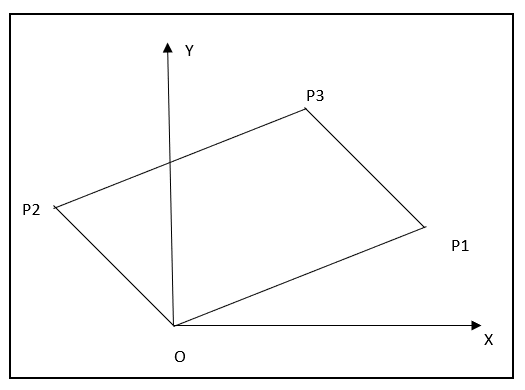
If the points ${{P}_{1}}$ and ${{P}_{2}}$ represent two complex numbers ${{z}_{1}}$ and ${{z}_{2}}$, then the point ${{P}_{3}}$ represents

A. ${{z}_{1}}+{{z}_{2}}$
B. ${{z}_{1}}-{{z}_{2}}$
C. ${{z}_{1}}\times {{z}_{2}}$
D. ${{z}_{1}}\div {{z}_{2}}$
Answer
216.6k+ views
Hint: In this question, we have to find the complex number at point ${{P}_{3}}$. For this, the property of parallelogram i.e., the midpoints of the diagonals of a parallelogram are equal is used.
Formula Used: The complex number $(x,y)$ is represented by $x+iy$.
If $z=x+iy\in C$, then $x$ is called the real part and $y$ is called the imaginary part of $z$. These are represented by $\operatorname{Re}(z)$ and $\operatorname{Im}(z)$ respectively.
$z=x+iy$ be a complex number such that $\left| z \right|=r$ and $\theta $ be the amplitude of $z$. So, $\cos \theta =\dfrac{x}{r},\sin \theta =\dfrac{b}{r}$
And we can write the magnitude as
$\begin{align}
& \left| z \right|=\left| x+iy \right| \\
& \Rightarrow r=\sqrt{{{x}^{2}}+{{y}^{2}}} \\
\end{align}$
Thus, we can write
$z=x+iy=r\cos \theta +ir\sin \theta =r(\cos \theta +i\sin \theta )$
This is said to be the mod amplitude form or the polar form of $z$.
Where $\cos \theta +i\sin \theta $ is denoted by $cis\theta $ and the Euler’s formula is $\cos \theta +i\sin \theta ={{e}^{i\theta }}$
Complete step by step solution: Given that,
The points ${{P}_{1}}$ and ${{P}_{2}}$ are represented by the complex numbers ${{z}_{1}}$ and ${{z}_{2}}$.
These are the vertices of the given parallelogram $O{{P}_{1}}{{P}_{2}}{{P}_{3}}$
So, the midpoints of its diagonals are equal. I.e.,
${{P}_{1}}{{P}_{2}}=O{{P}_{3}}$
The midpoint of ${{P}_{1}}{{P}_{2}}$ is
$\left( \dfrac{{{x}_{1}}+{{x}_{2}}}{2},\dfrac{{{y}_{1}}+{{y}_{2}}}{2} \right)\text{ }...(1)$
The midpoint of $O{{P}_{3}}$ is
$\left( \dfrac{0+x}{2},\dfrac{0+y}{2} \right)\text{ }...(2)$
On equating (1) and (2), we get
\[{{P}_{3}}(x,y)=({{x}_{1}}+{{x}_{2}},{{y}_{1}}+{{y}_{2}})\]
Thus, this point is represented in the complex form as
$\begin{align}
& ({{x}_{1}}+{{x}_{2}},{{y}_{1}}+{{y}_{2}})=({{x}_{1}}+{{x}_{2}})+i({{y}_{1}}+{{y}_{2}}) \\
& \Rightarrow ({{x}_{1}}+i{{y}_{1}})+({{x}_{2}}+i{{y}_{2}}) \\
& \Rightarrow {{z}_{1}}+{{z}_{2}} \\
\end{align}$
Thus, the point ${{P}_{3}}$ is represented by ${{z}_{1}}+{{z}_{2}}$.
Option ‘A’ is correct
Note: Here we need to remember that, the required point is one of the vertices of the given parallelogram. So, the property of the parallelogram is applied to find the required vertex.
Formula Used: The complex number $(x,y)$ is represented by $x+iy$.
If $z=x+iy\in C$, then $x$ is called the real part and $y$ is called the imaginary part of $z$. These are represented by $\operatorname{Re}(z)$ and $\operatorname{Im}(z)$ respectively.
$z=x+iy$ be a complex number such that $\left| z \right|=r$ and $\theta $ be the amplitude of $z$. So, $\cos \theta =\dfrac{x}{r},\sin \theta =\dfrac{b}{r}$
And we can write the magnitude as
$\begin{align}
& \left| z \right|=\left| x+iy \right| \\
& \Rightarrow r=\sqrt{{{x}^{2}}+{{y}^{2}}} \\
\end{align}$
Thus, we can write
$z=x+iy=r\cos \theta +ir\sin \theta =r(\cos \theta +i\sin \theta )$
This is said to be the mod amplitude form or the polar form of $z$.
Where $\cos \theta +i\sin \theta $ is denoted by $cis\theta $ and the Euler’s formula is $\cos \theta +i\sin \theta ={{e}^{i\theta }}$
Complete step by step solution: Given that,
The points ${{P}_{1}}$ and ${{P}_{2}}$ are represented by the complex numbers ${{z}_{1}}$ and ${{z}_{2}}$.
These are the vertices of the given parallelogram $O{{P}_{1}}{{P}_{2}}{{P}_{3}}$
So, the midpoints of its diagonals are equal. I.e.,
${{P}_{1}}{{P}_{2}}=O{{P}_{3}}$
The midpoint of ${{P}_{1}}{{P}_{2}}$ is
$\left( \dfrac{{{x}_{1}}+{{x}_{2}}}{2},\dfrac{{{y}_{1}}+{{y}_{2}}}{2} \right)\text{ }...(1)$
The midpoint of $O{{P}_{3}}$ is
$\left( \dfrac{0+x}{2},\dfrac{0+y}{2} \right)\text{ }...(2)$
On equating (1) and (2), we get
\[{{P}_{3}}(x,y)=({{x}_{1}}+{{x}_{2}},{{y}_{1}}+{{y}_{2}})\]
Thus, this point is represented in the complex form as
$\begin{align}
& ({{x}_{1}}+{{x}_{2}},{{y}_{1}}+{{y}_{2}})=({{x}_{1}}+{{x}_{2}})+i({{y}_{1}}+{{y}_{2}}) \\
& \Rightarrow ({{x}_{1}}+i{{y}_{1}})+({{x}_{2}}+i{{y}_{2}}) \\
& \Rightarrow {{z}_{1}}+{{z}_{2}} \\
\end{align}$
Thus, the point ${{P}_{3}}$ is represented by ${{z}_{1}}+{{z}_{2}}$.
Option ‘A’ is correct
Note: Here we need to remember that, the required point is one of the vertices of the given parallelogram. So, the property of the parallelogram is applied to find the required vertex.
Recently Updated Pages
SRMJEEE Result 2024 (Out) Check all the Updates Here

UPESEAT Exam Date 2023

GUJCET Exam Date 2023

TS EAMCET Application form 2023 & Exam Dates

MHT CET Cutoff 2023|Check Previous Year Cut off, Cutoff Trend

TS EAMCET Seat Allotment

Trending doubts
JEE Advanced Marks vs Ranks 2025: Understanding Category-wise Qualifying Marks and Previous Year Cut-offs

Difference Between Exothermic and Endothermic Reactions Explained

Top IIT Colleges in India 2025

IIT Fees Structure 2025

IIT CSE Cutoff: Category‐Wise Opening and Closing Ranks

Understanding the Mechanisms and Key Differences in SN1 and SN2 Reactions

Other Pages
JEE Main 2026: Application Form Open, Exam Dates, Syllabus, Eligibility & Question Papers

Derivation of Equation of Trajectory Explained for Students

NCERT Solutions for Class 11 Maths Chapter 10 Conic Sections

NCERT Solutions for Class 11 Maths Chapter 9 Straight Lines

Hybridisation in Chemistry – Concept, Types & Applications

NCERT Solutions For Class 11 Maths Chapter 8 Sequences And Series




